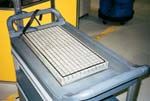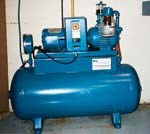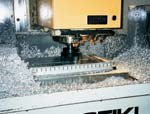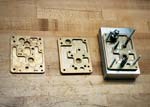Workholding With A Vacuum Chuck
An aerospace machine shop meets a special need by using a vacuum chuck.
Share




Manufacturing solutions are frequently the prizes for machine shop operators bold enough to resist the inertia of conventional wisdom. In the metalworking sphere, this inertia includes the premise that secure and reliable workholding is possible only by mechanical means. Considering the critical importance of accurate fixturing, it's no surprise that vacuum systems may be viewed with some uncertainty by machinists accustomed to conventional workholding devices.
In the past, acceptance of vacuum chucks has been limited by the persistence of traditional practices, as well as by some common misconceptions. Despite evidence to the contrary, for example, the belief persists that vacuum chucks aren't sturdy enough to withstand heavy machining operations. Another prevalent assumption is that vacuum chucks are only suitable for small workpieces. Reinforcing this view, many of the vacuum chucks in use today do serve in small applications. Machinists may also question whether a vacuum workholding system can be used with common coolant fluids. An additional factor is the ever-present concern about setup time.
Addressing these concerns was important to aerospace manufacturer Smiths Industries Actuation Systems (Whippany, New Jersey). Founded in 1947 as Airborne Accessories, the company specializes today in manufacturing actuation and motion-control systems for commercial and military aircraft, as well as for other types of military equipment. Many of the devices that Smiths manufactures are flight-critical components. The firm's current customer base is split roughly 50/50 between commercial and defense industries. With earnings last year of more than $52 million, Smiths currently has 280 employees, including 39 in its machine shop.
When their shop received an order in 1997 for thousands of parts incorporating aluminum plate components, manufacturing engineer Russ Harter and his supervisor Phil DeMauro needed to find a reliable and efficient workholding system to support their machining strategy. Due to the high cost of the aluminum castings that are used to create the majority of its precision parts, Smiths' machine shop performs only a small amount of unattended machining. Because most of the company's products are three-dimensional parts, receiving this special order involving plate components presented an entirely different type of workholding challenge.
As an alternative to setting up and machining each part separately, Mr. Harter wanted to machine several of the 0.160-inch-thick plates from a single, larger plate of aluminum alloy (Figure 1). Because of the very tight hole tolerances (±0.0005 inch) required for these parts, deflection of the workpiece needed to be minimal, and even the slightest positional shifting was unacceptable. Although a vacuum chuck seemed to be a logical solution, Mr. Harter had no previous experience using one of these devices.
To contact a shop with practical experience, Mr. Harter posted a message on Modern Machine Shop's Web site. He soon received a response from a machine shop in the Midwest that was successfully using a vacuum chuck system manufactured by Magna-Lock, U.S.A. (Rockford, Illinois), a firm that also manufactures magnetic chucks and related controls. After investigating other vacuum chuck products, Mr. Harter decided that this system was well-suited for his application.
How And Where It Works
Because a tight air seal is essential to the holding power of a vacuum chuck, application of these devices is limited to workpieces that incorporate flat, non-porous surfaces. Although one application is to hold flat sheet metal for grinding, polishing or welding, a vacuum chuck performs equally well with thicker metal plates, narrow metal channels or aluminum extrusions that incorporate flat surfaces. A vacuum workholding system can be expanded to accommodate very large workpieces. For example, vacuum chucks have been used successfully for gantry-type welding machines with table surfaces as large as 12 feet by 40 feet.
Like a magnetic chuck, a vacuum chuck operates simply by flipping a control lever. Unlike a magnetic chuck, however, a vacuum chuck is suitable for holding non-ferrous metals or any other flat, non-porous material. In contrast to mechanical clamps or jigs that concentrate pressure in small areas, a vacuum chuck applies uniform holding pressure simultaneously to the workpiece's entire abutting surface. This prevents deflection of the part during machining.
The vacuum chuck that Smiths uses is composed of dimensionally stable cast aluminum tooling plate. Its maximum holding power is approximately 13 pounds per square inch, which equates to nearly a ton of holding force per square foot of the workpiece. Despite this strong vacuum, however, ordinary, water-soluble coolants can be used without affecting the chuck's performance. The pumping system (Figure 2) incorporates a sliding vane-type vacuum pump driven by an electric motor, plus a ceramic filter that removes fine particles from the evacuated coolant. The coolant, in turn, collects in the vacuum reservoir from which it can be periodically drained.
Mr. Harter reports that installing the vacuum chuck is a relatively simple task. The rectangular chuck incorporates grooves near its four lower corners that accept T-slot straps to fasten it to the machine's worktable. This type of chuck is also available with a ¼-inch ground steel back that enables it to be fastened magnetically to a machine table. Operation requires connecting only a single vacuum line from the control valve (Figure 3).
The chuck's flexibility for holding various sizes and shapes of workpieces derives from its method of sealing-off vacuum leakage. The air seal is maintained by flexible, silicone "Channel-Seal" strips that resemble weather-stripping for doors or windows (Figure 4). Ranging from 1/16- to ¼-inch thickness, these strips fit into vacuum grooves that are recessed into the chuck's surface, forming a grid pattern. Because the sealer strip is slightly wider than the vacuum grooves, the workpiece compresses the protruding portion of the strip when vacuum pressure is applied. The compressed strip effectively seals off air leakage to maintain vacuum. These reusable strips can be quickly adjusted when changing the workpiece's size or shape.
The Job At Hand
Smiths uses the vacuum chuck to machine special cover plates for a gearbox that is part of the actuation mechanism for a commercial jetliner's climate control system (Figure 5). Because these plates incorporate numerous holes that retain small, precision gear shafts, the hole locations are critical to the actuator's operation.
When they set up the job, Mr. Harter and machinist Scott Jenkins matched the size of the aluminum alloy workpiece to the 30-inch by 12-inch dimensions of the vacuum chuck. Covering the chuck's entire surface with the workpiece prevents metal chips from falling into the vacuum grooves, thus eliminating the need for continual, time-consuming cleaning between workpiece changes. The shop used Pro/ENGINEER software to create a part program for machining 18 parts from each slab of aluminum alloy stock. The finished, 0.160-inch-thick plates are considerably thinner, however, than the stock from which they are machined. This is due to Smiths' initial concern about possibly machining the material too thin to withstand the chuck's strong vacuum pressure. One of the firm's engineers tested this holding force and found it to be considerably greater than the amount necessary to securely hold the workpiece.
But after considerable experience using the vacuum chuck, and based on the manufacturer's guidelines, Mr. Harter believes that metal plates can be machined quite thin with no risk of damage or failure. To hold extremely thin sheet metal (less than 0.020-inch thick), however, the chuck manufacturer recommends using a separate top plate adapter with multiple vacuum ports that distribute the vacuum pressure more widely.
By setting up its machining cycle to create 18 identical parts at once, the shop drastically reduced the total number of setups and tool changes. Although Mr. Harter is currently running these parts on an older Mitsui Seiki vertical machining center that lets him achieve a maximum cutting speed of 500 sfm, he is confident that the vacuum chuck would work equally well at twice this cutting speed. With his present setup, Mr. Harter averages only 10 minutes to produce each part. After two years' experience with the vacuum workholding system, Smiths has not produced a single bad part due to movement of the workpiece.
Alternative Setups
Vacuum chucks can also be used effectively for rotary applications including grinding and turning, as well as on indexing tables. For these applications, a rotating coupling is used to attach the vacuum line inlet at the center of the chuck's underside. Vacuum chucks are available in circular or square-grid shapes to meet specific workholding needs, and the orientation can be adjusted according to the type of machine being used. Depending on how a shop plans to attach the chuck, it may be an aluminum-backed or steel-backed type. Vacuum chucks may be attached to machines via mechanical or magnetic means.
The larger the chuck's surface area, the greater the required capacity of the vacuum system. Vacuum pumps are rated according to the ultimate vacuum they can achieve, which is commonly expressed in standard cubic feet per minute (SCFM). Because all vacuum systems experience some leakage, the pumping system must be designed to compensate for this operating load.
Filling A Niche
Because vacuum chucks are simple to install or remove from various machines, they can be used periodically to run compatible parts without significantly disrupting normal operations. In cases where flat workpieces are too fragile or thin to withstand mechanical workholding, a vacuum chuck can represent a valuable and reliable solution. Smiths Industries has already discovered that vacuum workholding makes sense for filling a niche application. By adding another tool to its arsenal, however, the shop has created the opportunity to consider additional applications.
Related Content
Navigating Large-Scale CNC Machining: Suburban Tool’s Niche Strategy to Stay Competitive
Facing increasing competition from lower-cost imports, Suburban Tool made a move toward large-scale, in-house machining. By identifying a niche in large, precision angle plates and tombstones, the company has strengthened its ability to control quality and protect its reputation.
Read MoreParts and Programs: Setup for Success
Tips for program and work setups that can simplify adjustments and troubleshooting.
Read MoreWorkholding Fixtures Save Over 4,500 Hours of Labor Annually
All World Machinery Supply designs each fixture to minimize the number of operations, resulting in reduced handling and idle spindle time.
Read MoreLean Approach to Automated Machine Tending Delivers Quicker Paths to Success
Almost any shop can automate at least some of its production, even in low-volume, high-mix applications. The key to getting started is finding the simplest solutions that fit your requirements. It helps to work with an automation partner that understands your needs.
Read MoreRead Next
Registration Now Open for the Precision Machining Technology Show (PMTS) 2025
The precision machining industry’s premier event returns to Cleveland, OH, April 1-3.
Read MoreSetting Up the Building Blocks for a Digital Factory
Woodward Inc. spent over a year developing an API to connect machines to its digital factory. Caron Engineering’s MiConnect has cut most of this process while also granting the shop greater access to machine information.
Read More



























.jpg;maxWidth=300;quality=90)








